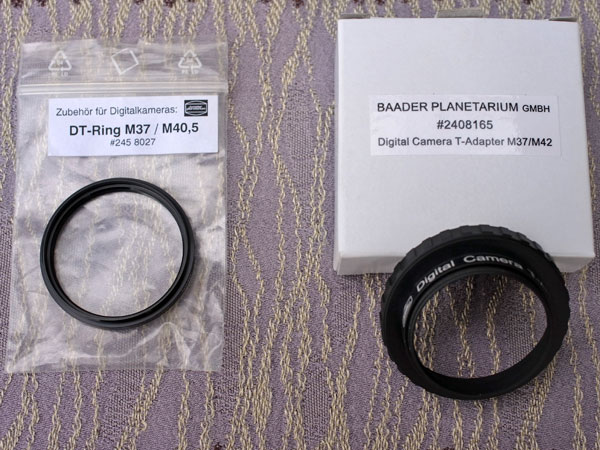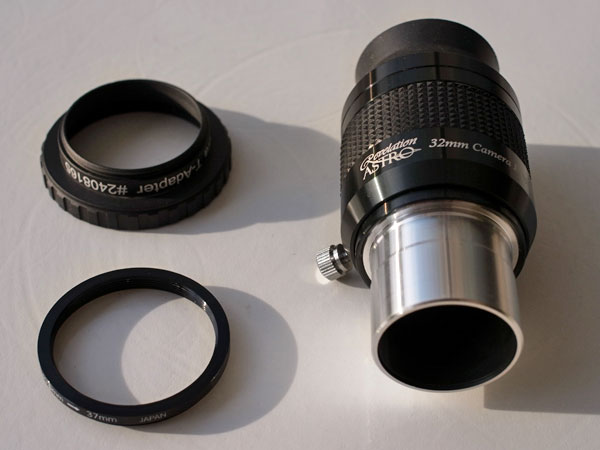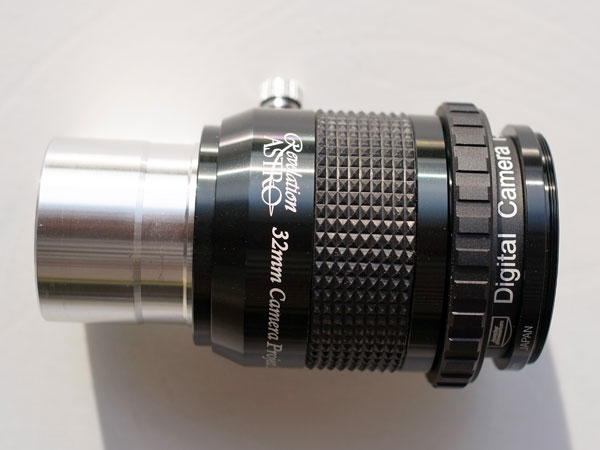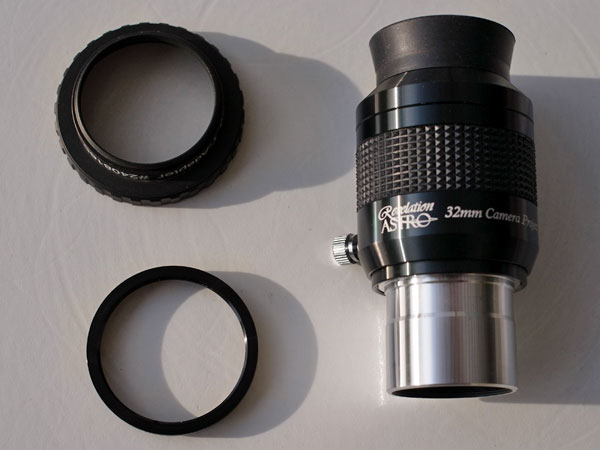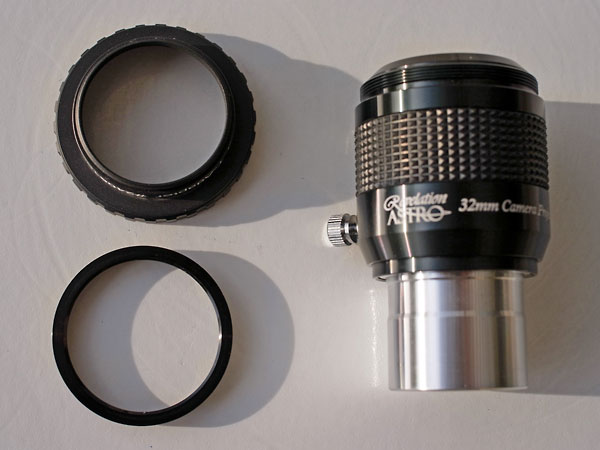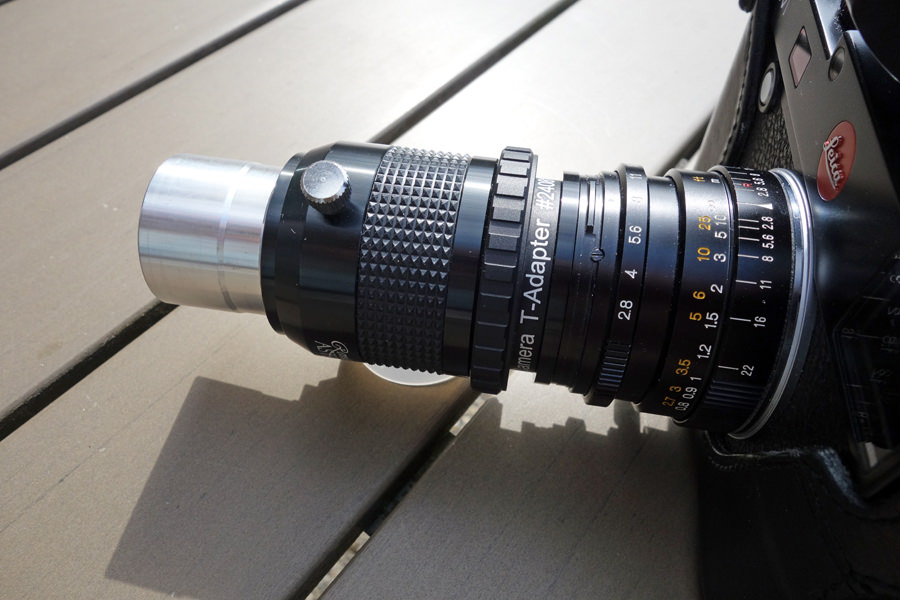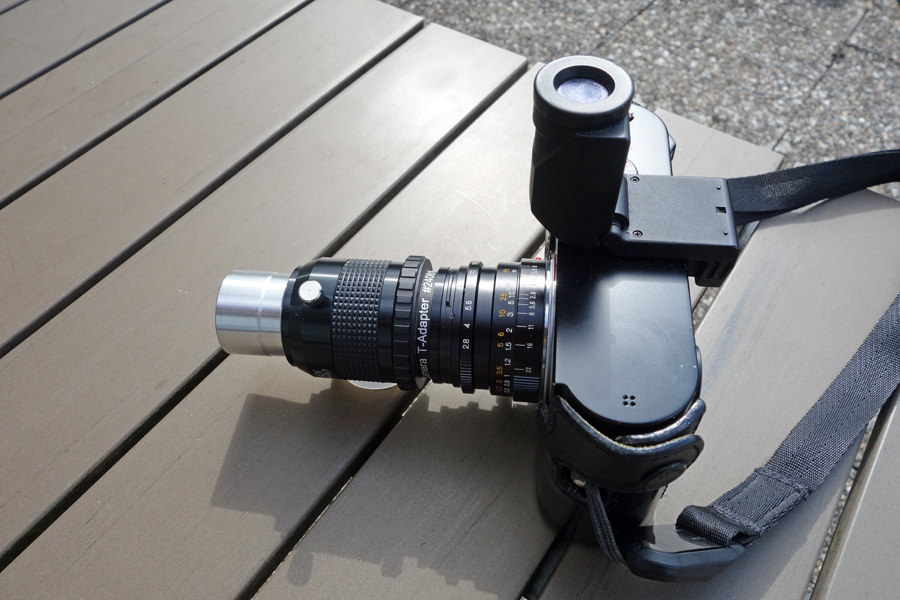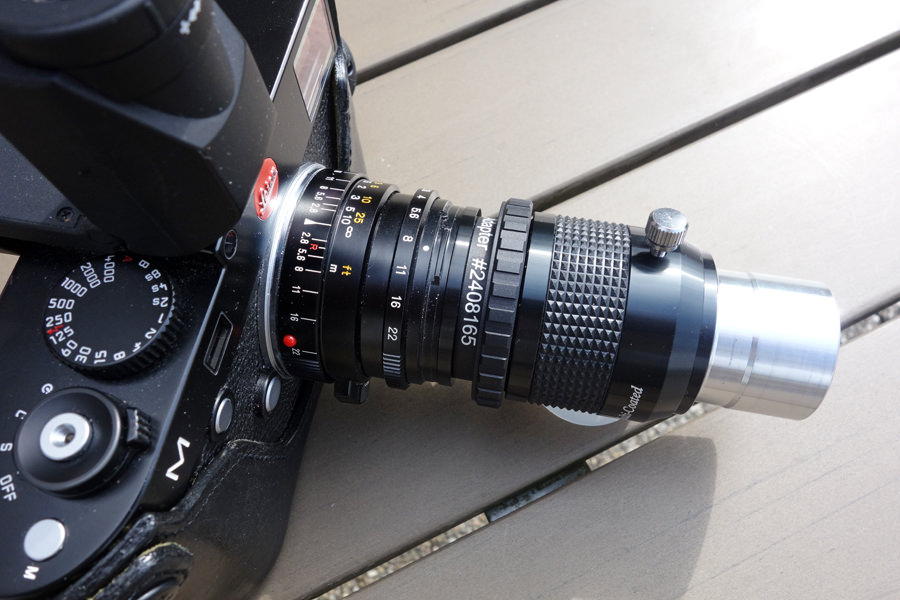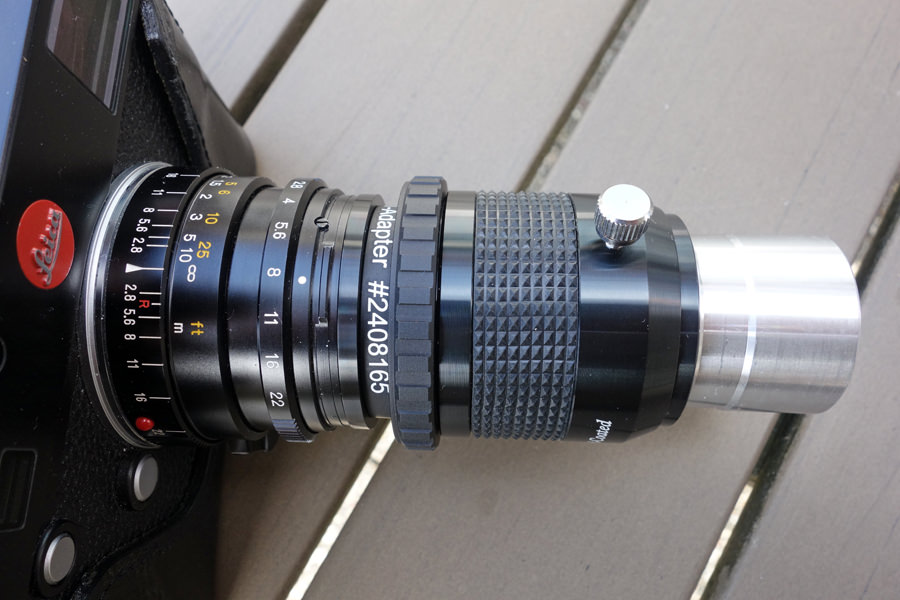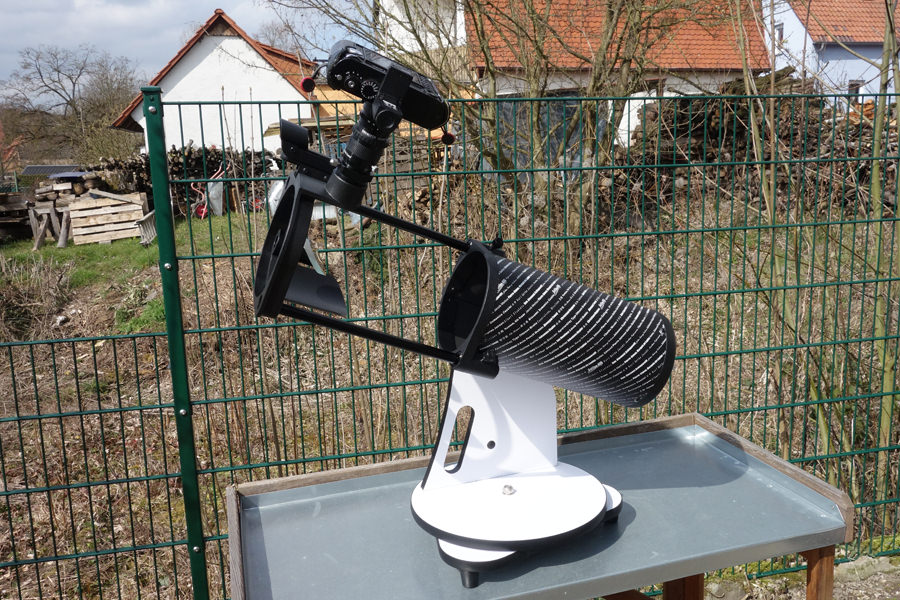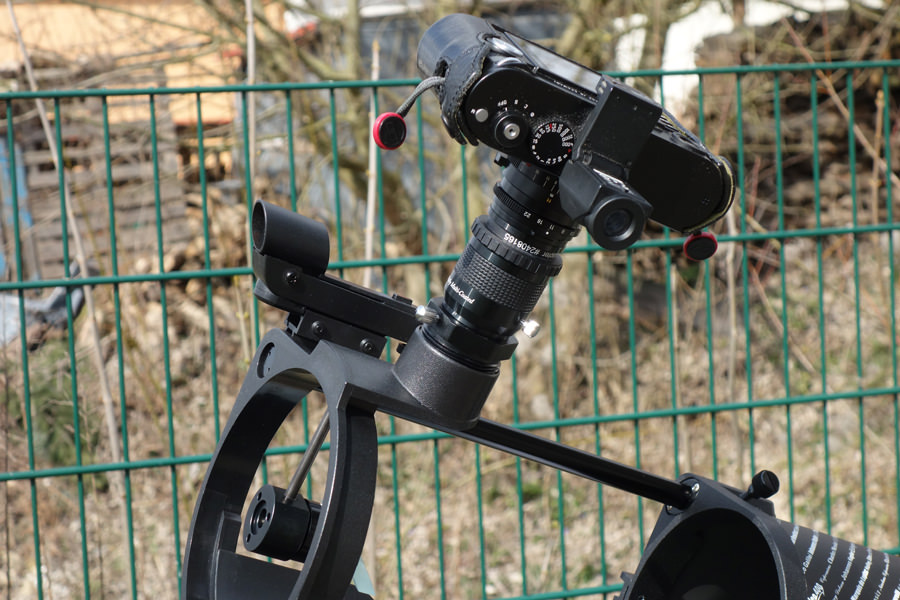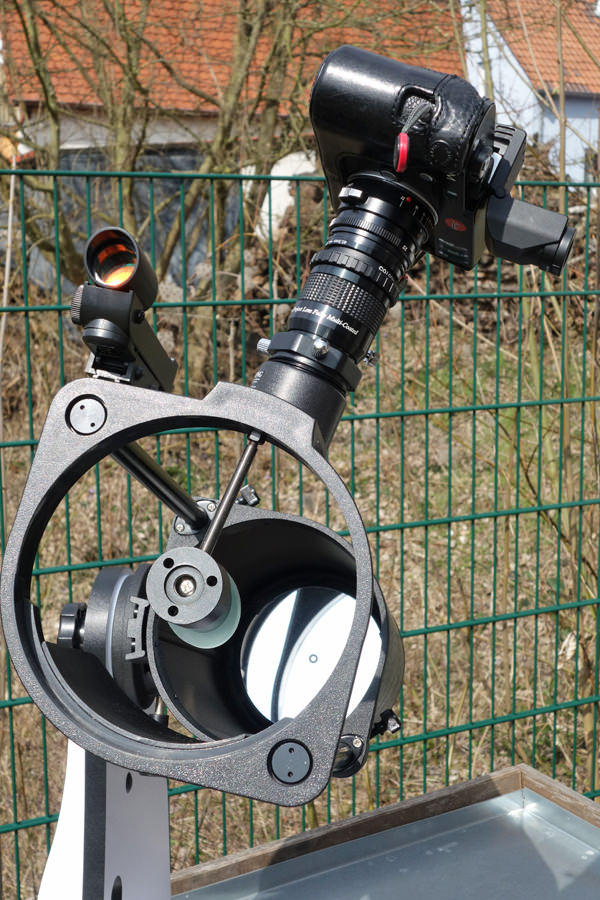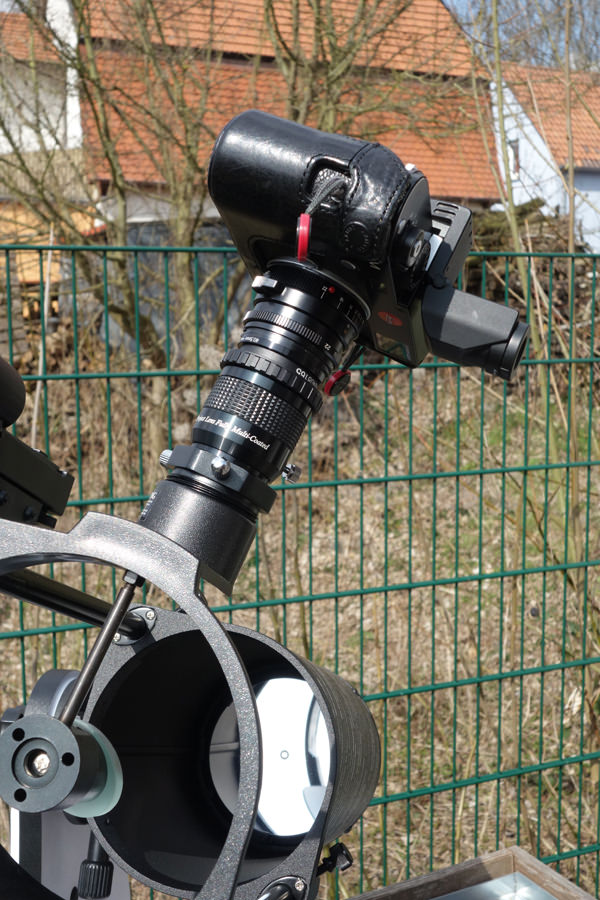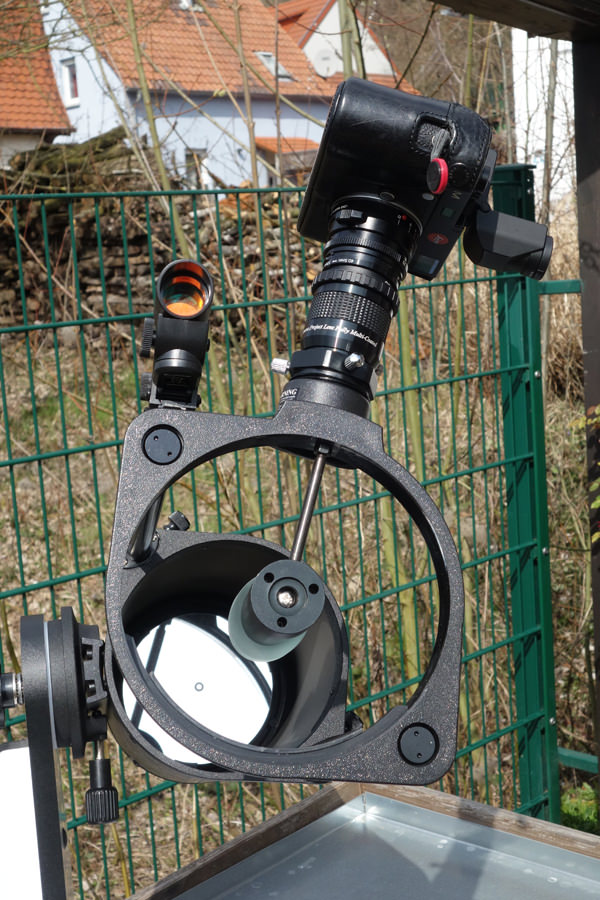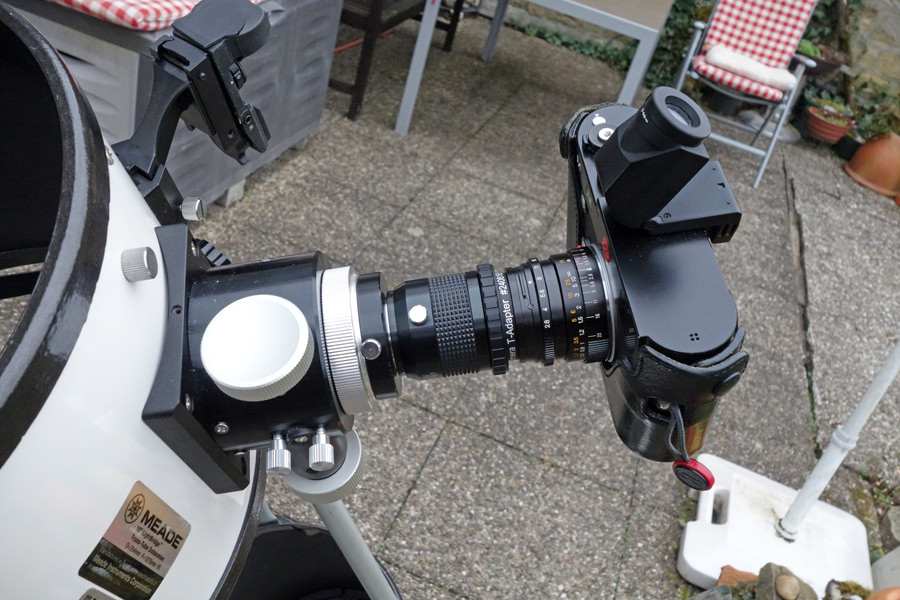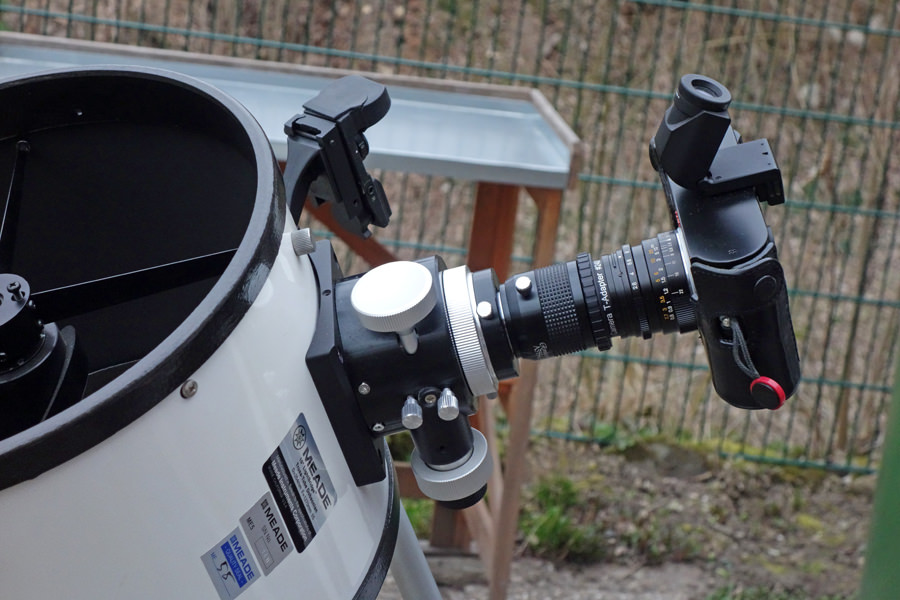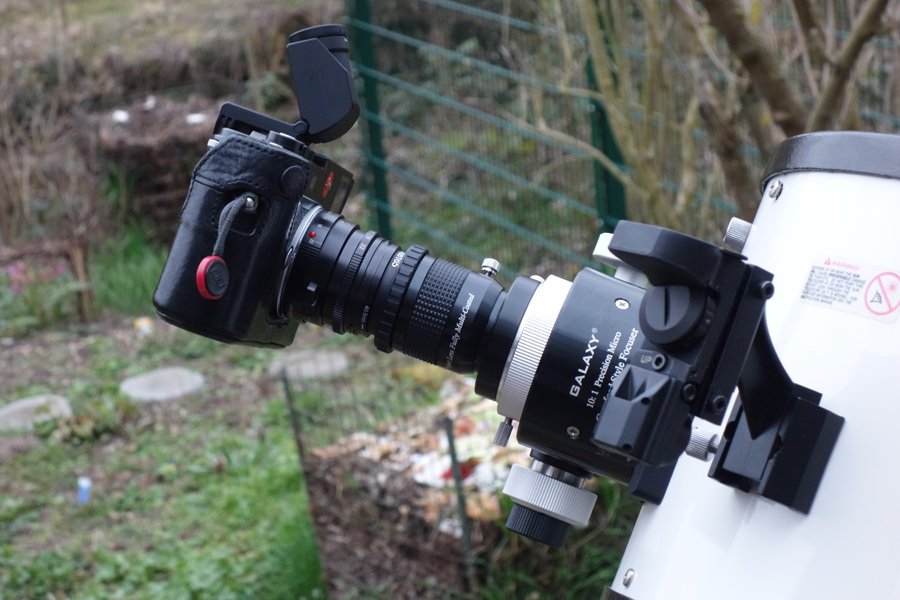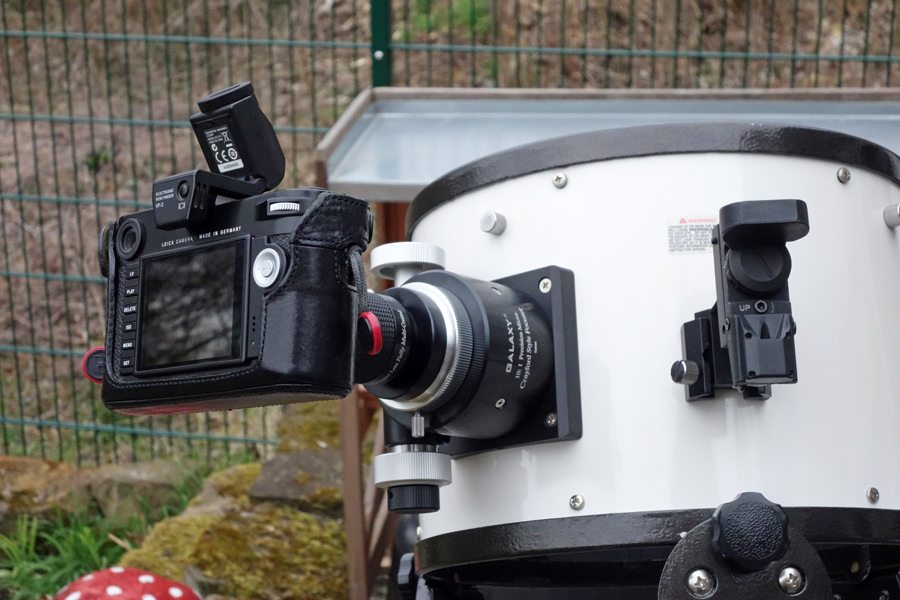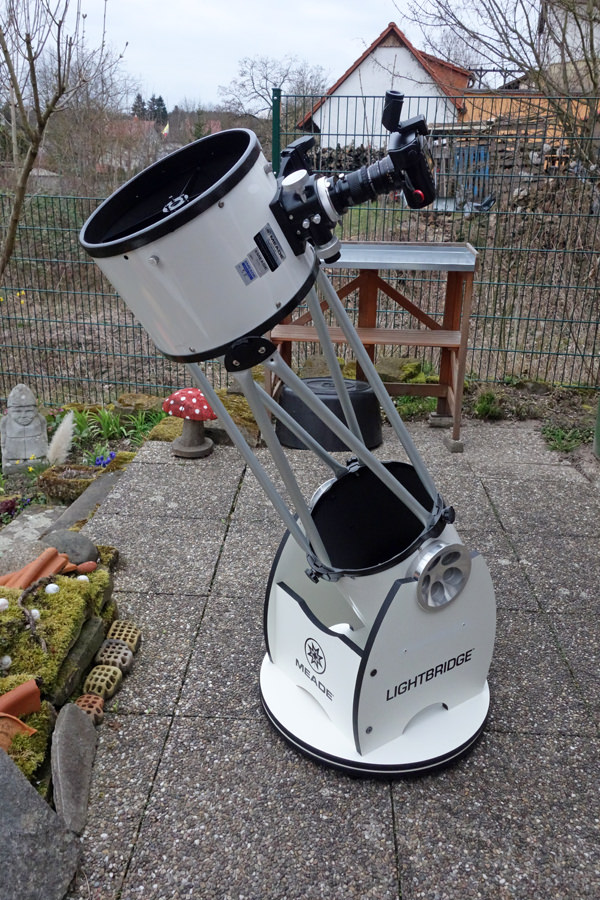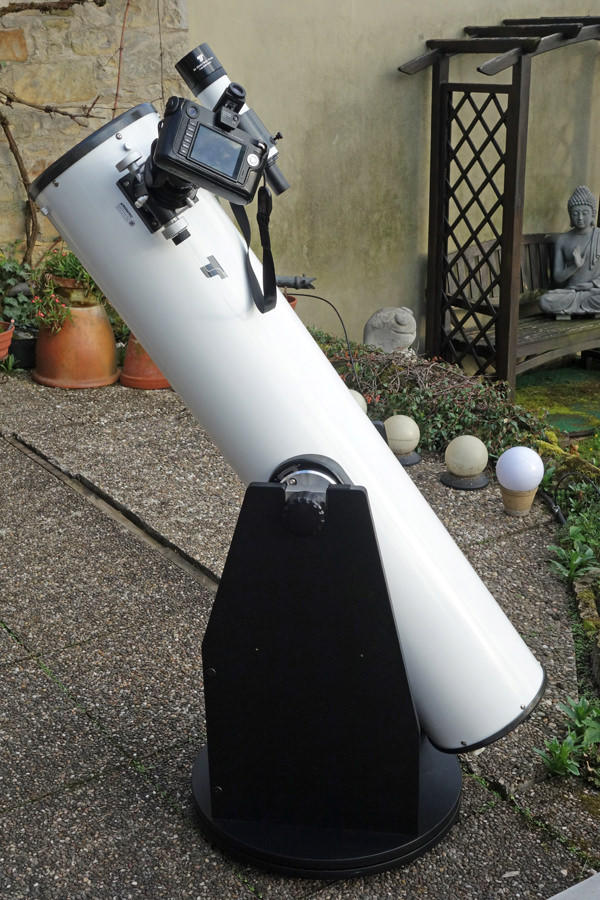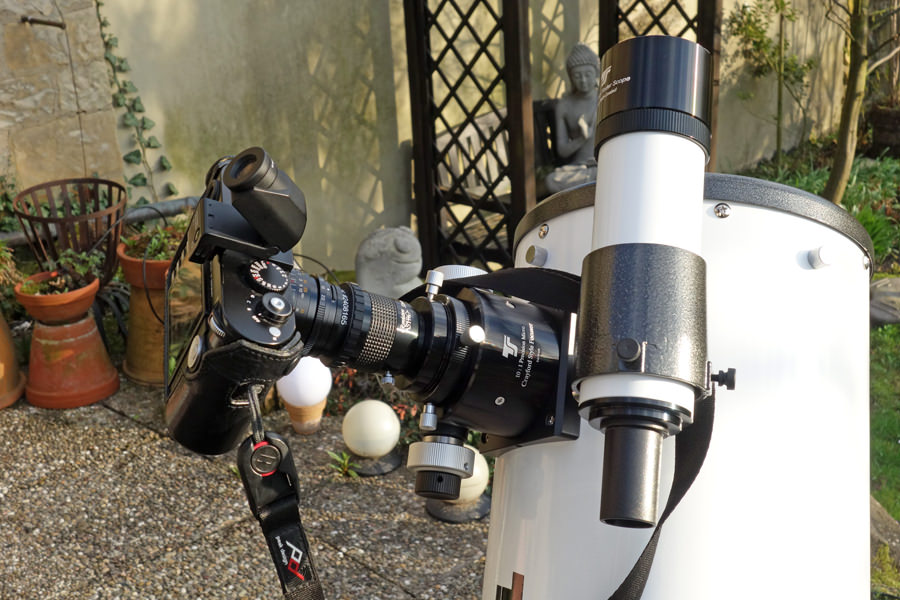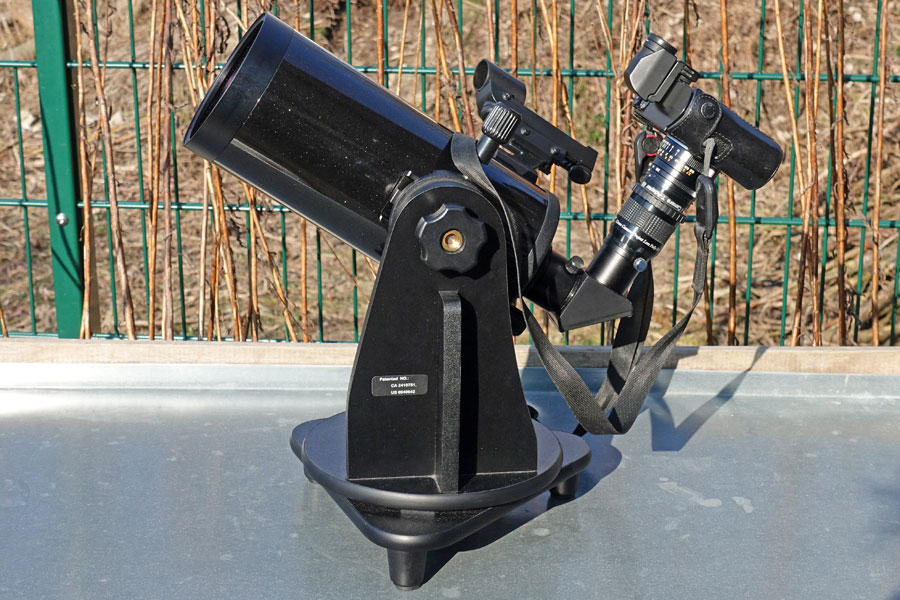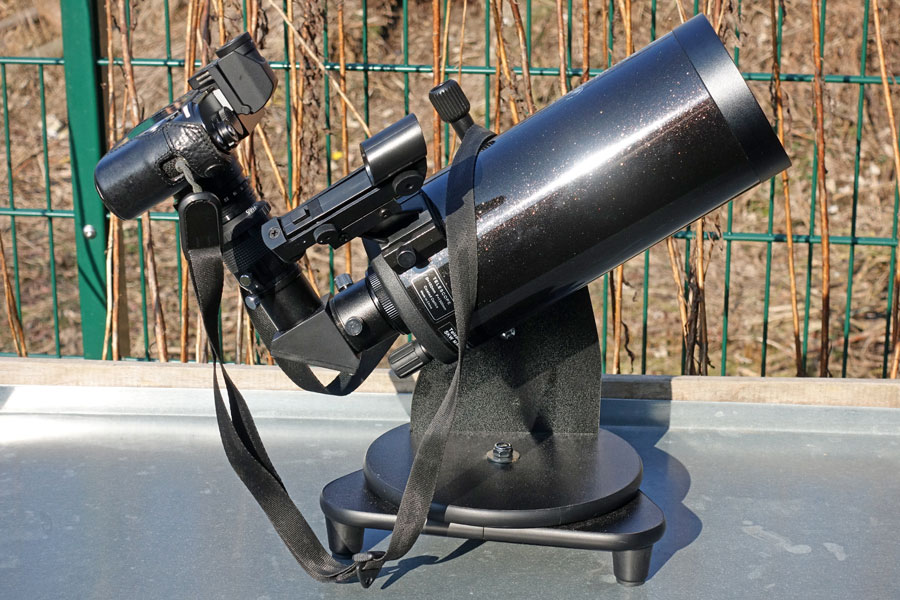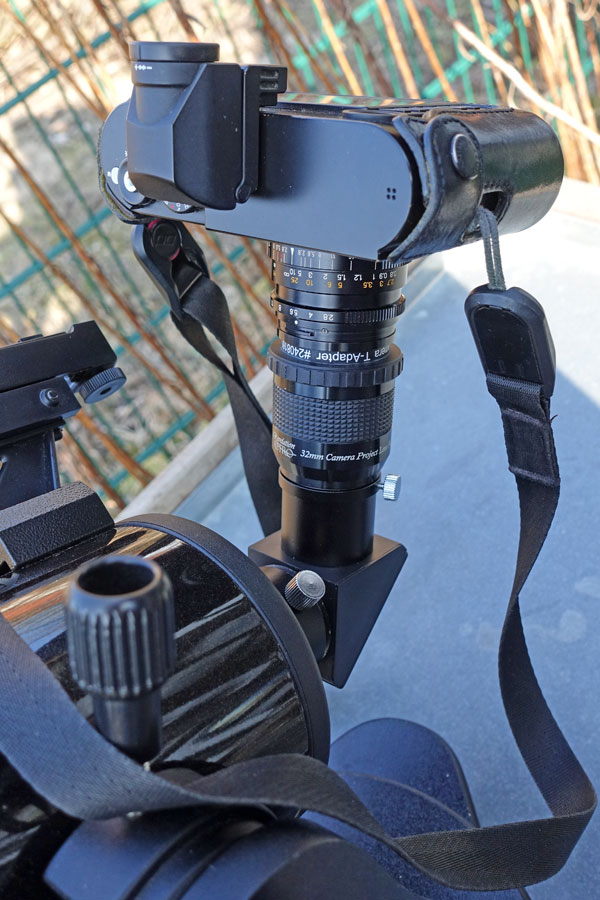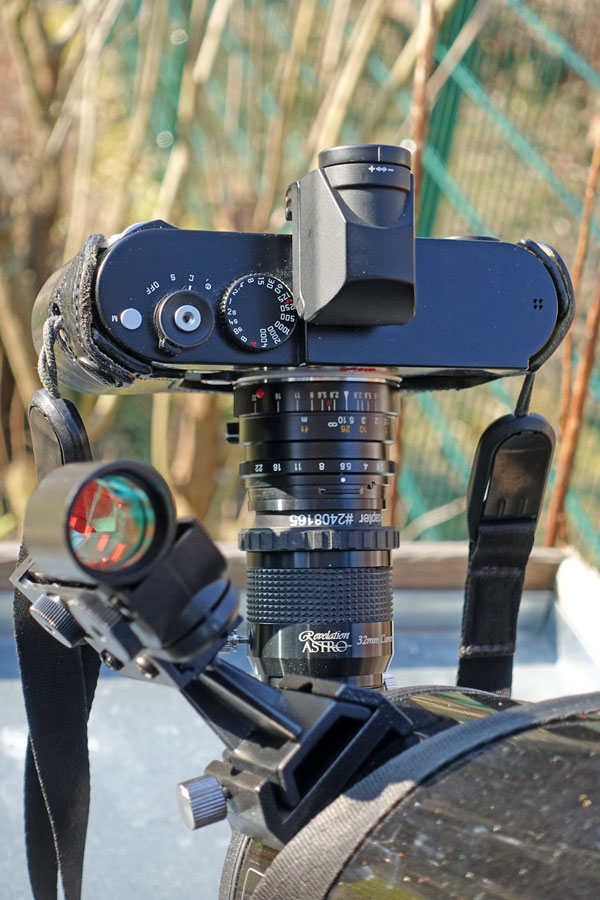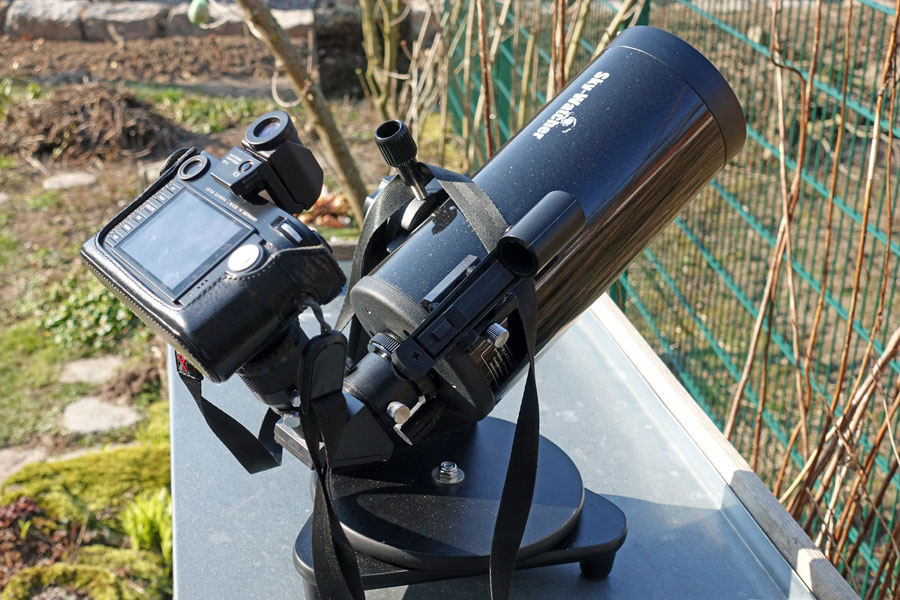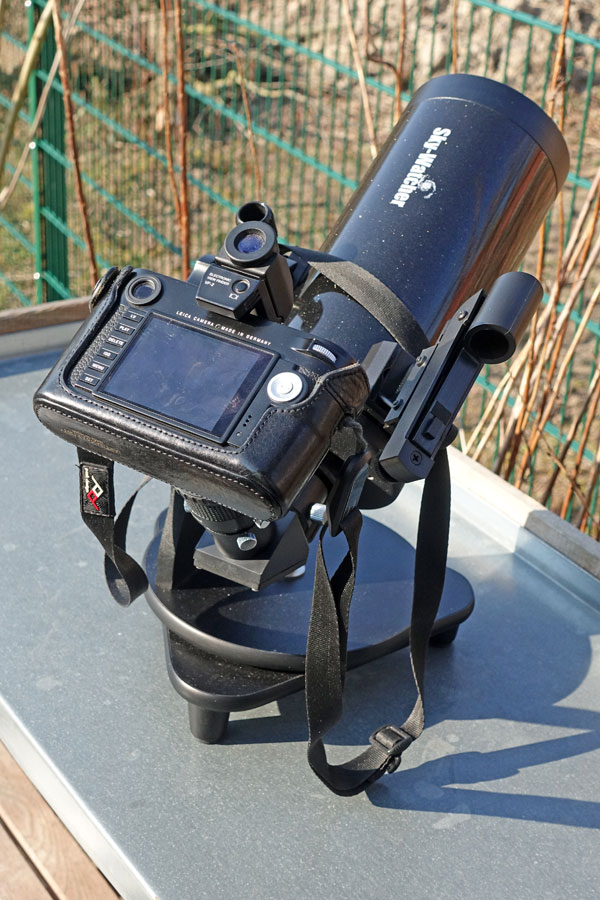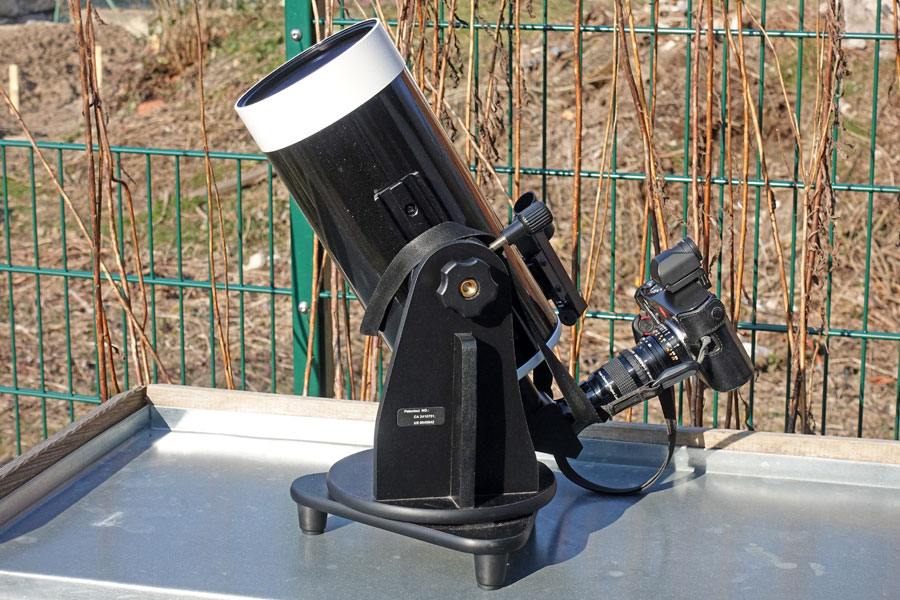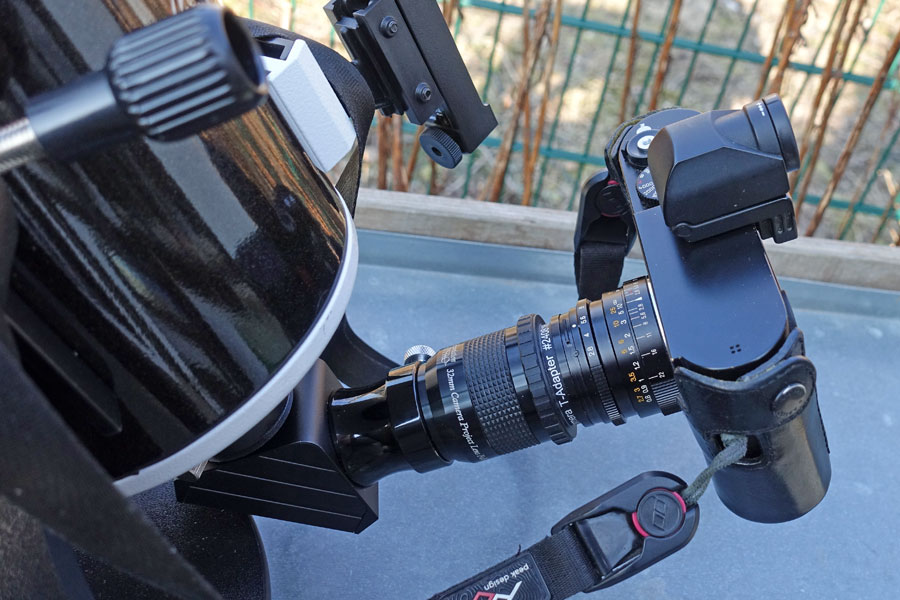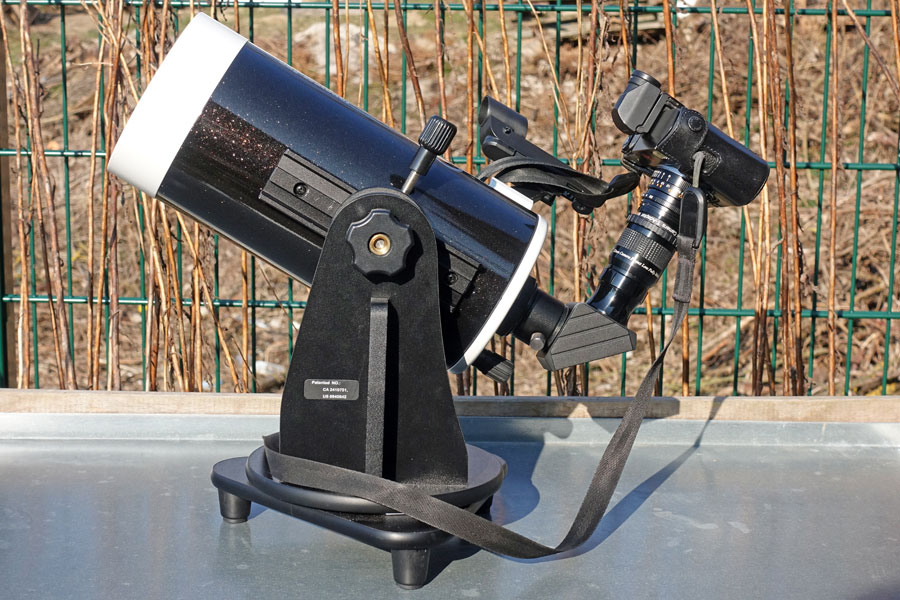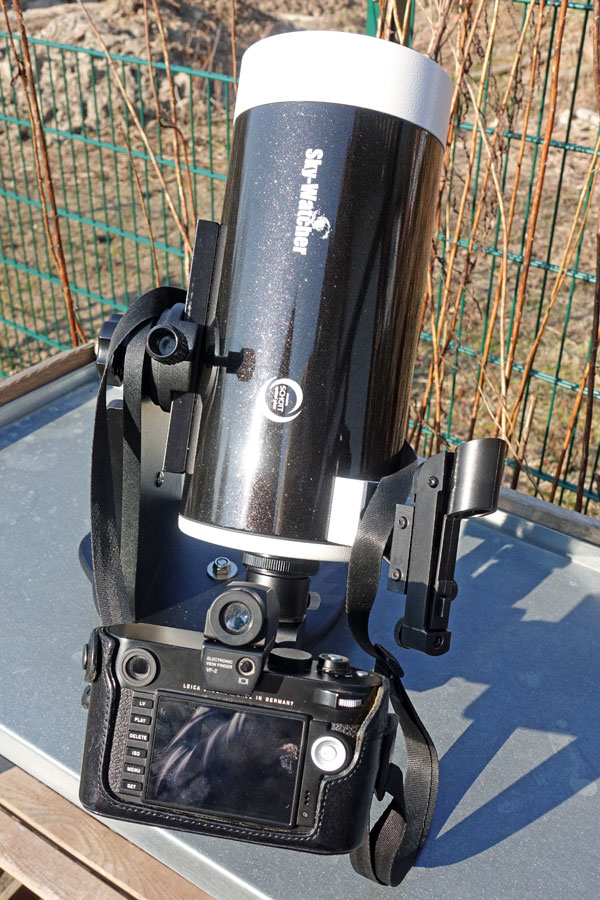Leica M (Typ 240) Attached to Telescope (1)
Prolog... | Eyepiece and Adapters | Camera Attached to Eyepiece | Camera Attached to Heritage P130 Telescope | Camera Attached to Meade 10" Dobson Telescope | Camera Attached to GSO GSD 680 8" Telescope | Camera Attached to Skymac-102 Telescope | Camera Attached to Skymax-127 Telescope
Archive
On this page, I demonstrate how I attach the Leica M (Typ 240) with a Minolta M-Rokkor 28 mm f/2.8 lens to a telescope eyepiece with a T-mount filter thread for taking astro photos using the projection technique. Projection technique means that the camera is mounted to the eyepiece, not directly to the telescope. The latter technique can only be used with SLR or system cameras where the body can be directly attached to the telescope - typically using a T mount adapter.
BTW: I mention the 1:50 method on this site several times. This is a simple variant of the projection technique - you hold the camera by hand to the eyepiece instead of attaching it firmly...
Note: Since I no longer own some of the telescopes mentioned on this page, I can no longer offer any further information about these configurations and photos taken with these. |
Prolog...
At the beginning a few warnings:
- Special care must be taken that the front lens of the camera and the front lens of the eyepiece do not touch and damage each other!
- If you need to use several adapters rings and attach these to the camera lens, you are in danger of tightening the rings too strongly so that you cannot separate them from each other when disassembling everything. Particularly, the DT ring may stick either to the camera lens or to the adapter to which it is attached - I experienced already both cases... As I do not like to grasp the adapters with tongs, I used a rubber blanket from our kitchen gear (used for opening glass containers or bottles) for separating adapters - with success. However, special tools for unscrewing the adapters would be much more helpful...
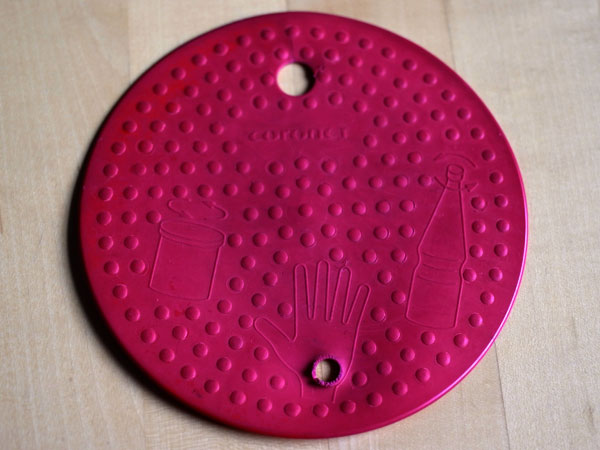
Eyepiece and Adapters
Here, you can see the Revelation 32 mm DigiScope eyepiece and the two adapters needed to mount the Leica M (Typ 240) with a Minolta M-Rokkor 28mm f/2.8 lens to the eyepiece. A second adapter, Baader DT ring adapter M37/M40.5 (or a step-down ring 40.5-37), is required, because there is no T mount adapter available, which directly fits the filter thread of the M-Rokkor lens (40.5 mm).You can remove the upper part of the eyepiece including the eyecup to reveal the T mount filter thread.
|
Left: Baader DT ring adapter M37/M40.5 (#2458027); right: Baader digital camera T mount adapter M37/M42 (#2408165) |
Top left: Baader T mount adapter M42/M37; bottom left: Baader DT ring adapter M37/M40.5; right: Revelation 32 mm DigiScope eyepiece |
Revelation 32 mm DigiScope eyepiece - eyecup removed and adapters attached |
|
Top left: Baader T mount adapter M42/M37; bottom left: Baader DT ring adapter M37/M40.5; right: Revelation 32 mm DigiScope eyepiece |
Top left: Baader T mount adapter M42/M37; bottom left: Baader DT ring adapter M37/M40.5; right: Revelation 32 mm DigiScope eyepiece |
Top left: Baader T mount adapter M42/M37; bottom left: Baader DT ring adapter M37/M40.5; right: Revelation 32 mm DigiScope eyepiece - eyecup removed |
Camera Attached to Eyepiece
Here, you can see the Leica M (Typ 240) with a Minolta M-Rokkor 28mm f/2.8 lens attached to the Revelation 32 mm DigiScope eyepiece:
|
Detail view |
Overview |
|
Detail view |
Overview |
|
Detail view from above |
Camera Attached to Heritage P130 Telescope
Here, you can see the Leica M (Typ 240) with Minolta M-Rokkor 28mm f/2.8 lens attached to the Dobsonian telescope Sky-Watcher Heritage P130 and the Revelation 32 mm DigiScope eyepiece:
|
Complete view |
Detail view |
|
Front view |
Front view |
Front view |
|
Results cannot be published, since I gave the Sky-Watcher P130 telescope away to a friend April 2017.
Camera Attached to Meade 10" Dobson Telescope
Note: Since I no longer own the Meade 10" Dobson telescope, I cannot offer any further information on this configuration and photos taken with it.
Here, you can see the Leica M (Typ 240) with Minolta M-Rokkor 28mm f/2.8 lens attached to the Meade 10" Dobson telescope and the Revelation 32 mm DigiScope eyepiece:
|
Detail view |
Detail view |
|
Detail view |
Detail view |
|
Complete view |
Complete view |
Results cannot be published, since I sold the Meade 10" Dobsonian telescope in March 2016.
Camera Attached to GSO GSD 680 8" Telescope
Here, you can see the Leica M (Typ 240) with Minolta M-Rokkor 28mm f/2.8 lens attached to the 8" Dobsonian telescope GSO GSD 680 and the Revelation 32 mm DigiScope eyepiece:
|
Complete view |
Detail view |
Results cannot be published, since I gave the GSO GSD 680 8" Dobsonian telescope to a dealer for selling it in April 2017.
Camera Attached to Skymax-102 Telescope
Here, you can see the Leica M (Typ 240) with Minolta M-Rokkor 28mm f/2.8 lens attached to the Sky-Watcher Skymax-102 Maksutov-Cassegrain telescope and the Revelation 32 mm DigiScope eyepiece.
Attention: The small Dobson base (taken from the Heritage 100P) is extremely wobbly and shaky and therefore not a "recommendation," but only shown here for demonstration purposes. If I actually use this base, I hang the camera's shoulder strap around my neck to avoid the worst!
Results
On February 27, 2018, I took a series of moon photos with my Leica M (Type 240) and a Minolta 28 mm lens attached to the eyepiece. Most of the resulting photos were, however, blurred. In order to investigate the conditions for the camera shake more closely, I varied the exposure times. In contrast to the Skymax-127, I got the relatively clear result that shots under 1/1000 sec exposure time are mostly blurred. For 1/1000 sec and shorter, I am often lucky that they are sharp. Even shorter exposure times lead to underexposure and would have to be compensated by a higher ISO number (I already used ISO 3200). Neither underexposure nor a higher ISO number increase the quality of the photos...
Conclusion: Only with very short exposure times do I get really sharp photos with this combination, and typically, that is rarely the case. The potential is there, but the results with the Skymax-127 seem to be slightly better than those with the Skymax-102. This may, however, also be due to the selected images or just coincidence...
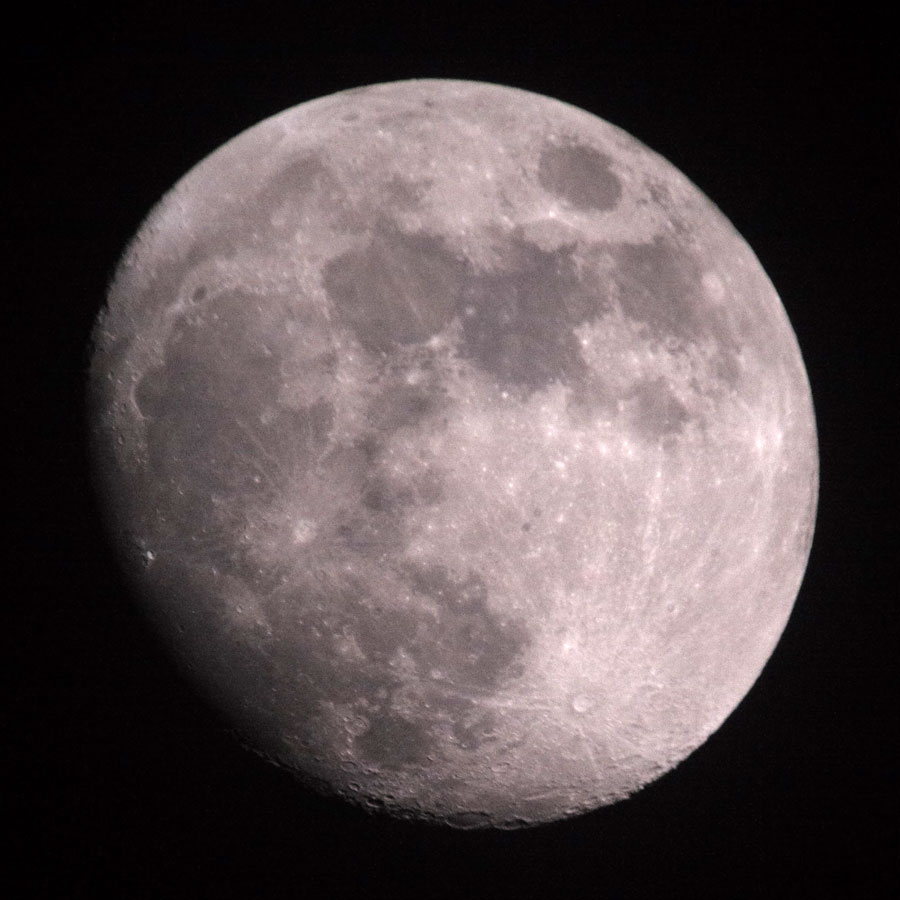 |
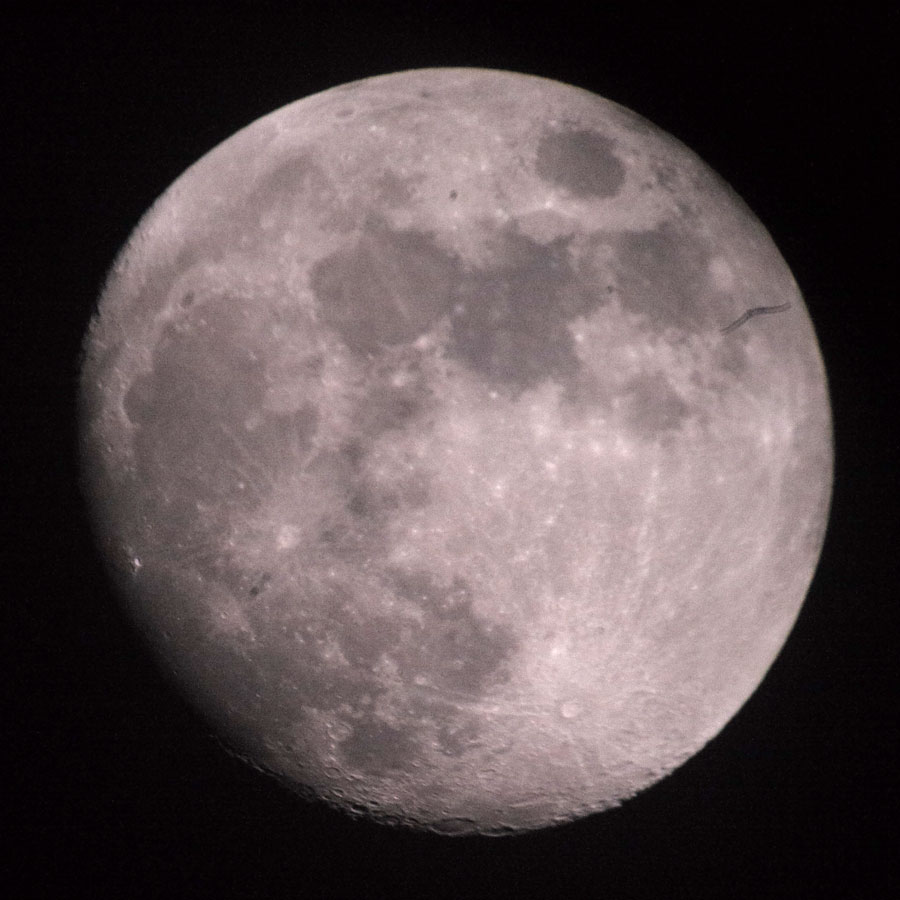 |
|
Post-processed, exposure time 1/1000 - 2400 pixels |
Post-processed, exposure time 1/1000 - 2400 pixels |
|
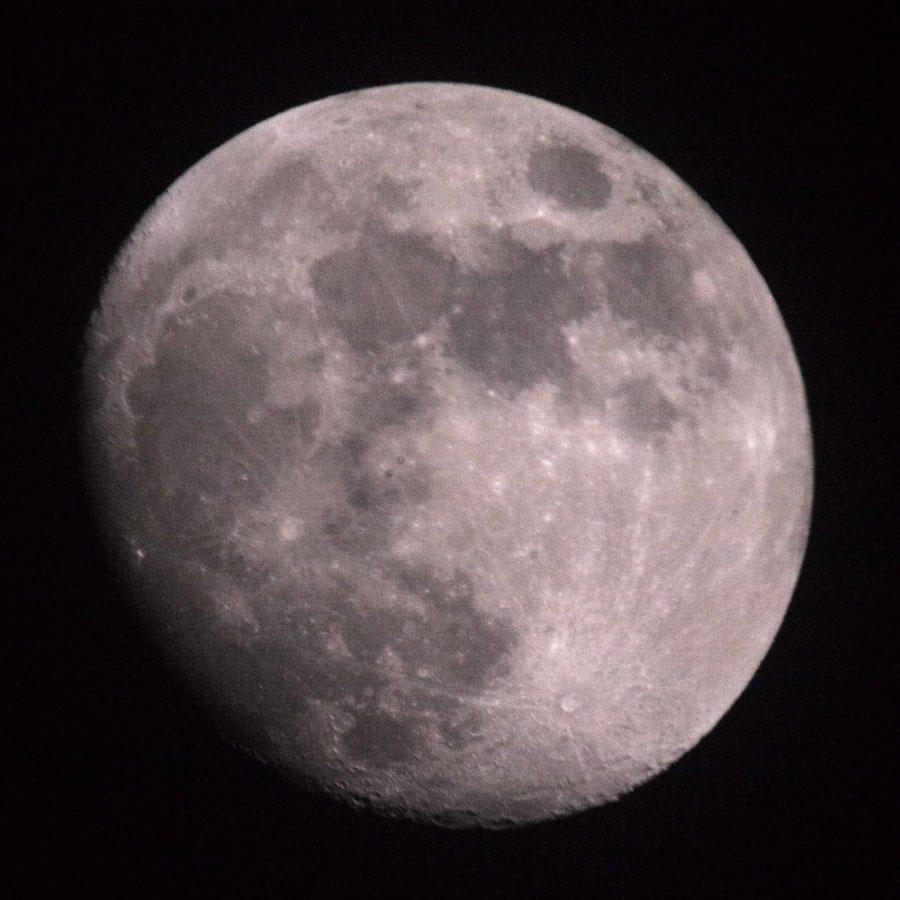 |
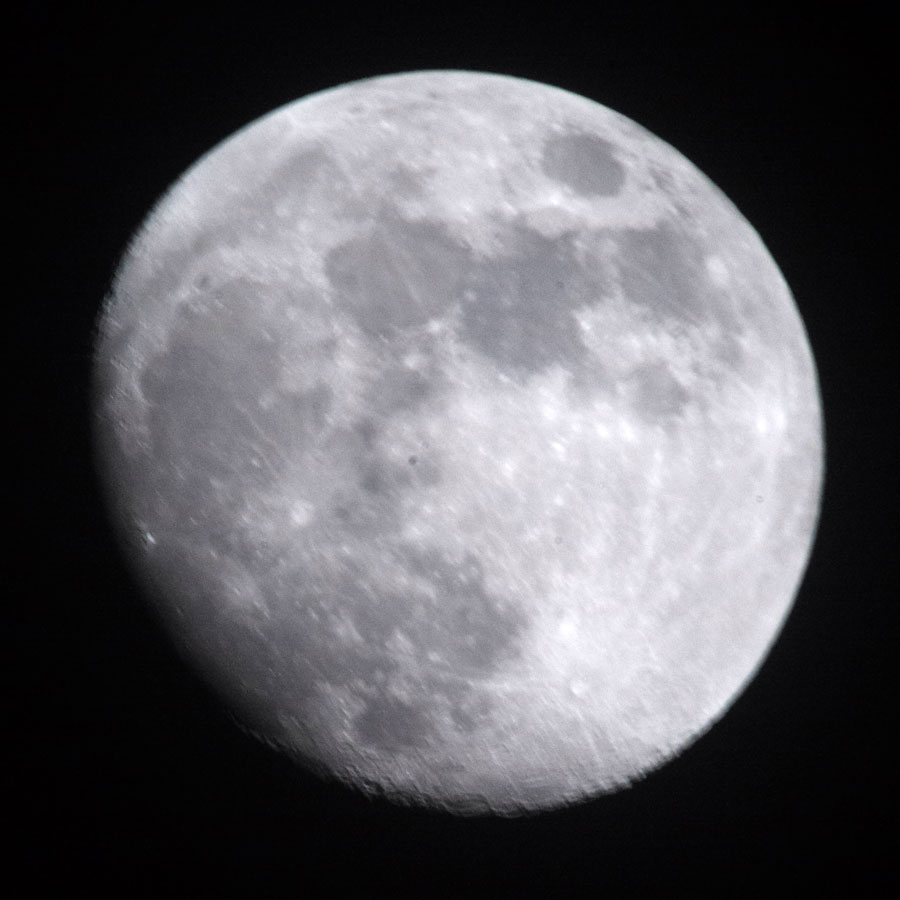 |
|
Post-processed, exposure time 1/1500, somewhat underexposed - 2400 pixels |
Post-processed, exposure time 1/500, blurred - 2400 pixels |
|
 |
 |
|
Section from the southern hemisphere, my sharpest sample |
Ditto; same exposure time, but less sharp |
|
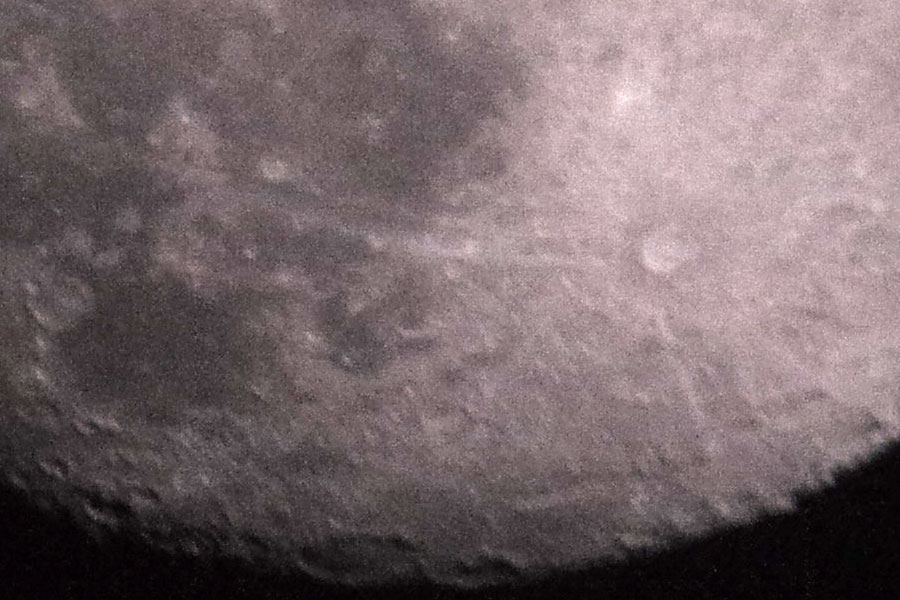 |
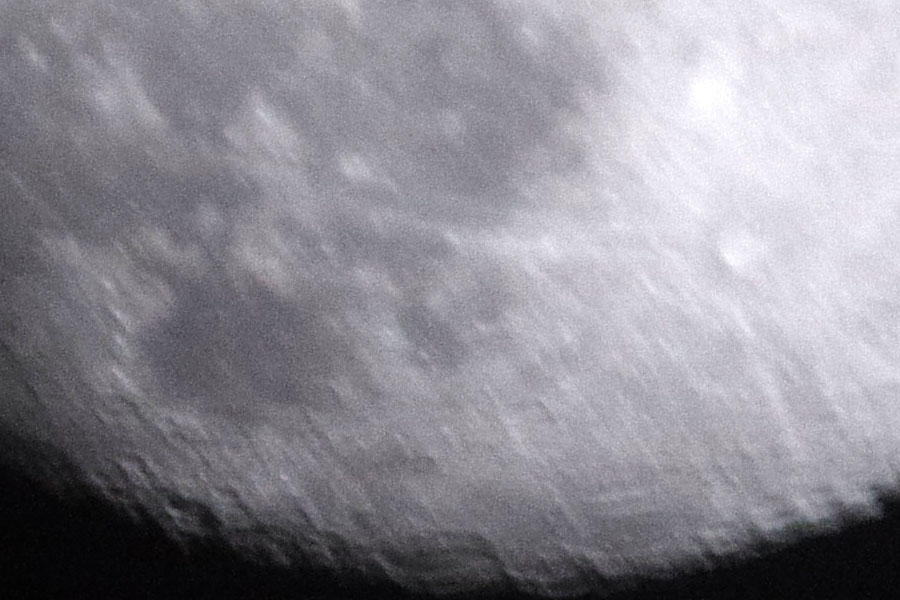 |
|
Ditto; more noise due to underexposure and less sharp than the photo abov... |
Ditto; blurred, because of 1/500 sec exposure time ... |
Camera Attached to Skymax-127 Telescope
Here, you can see the Leica M (Typ 240) with Minolta M-Rokkor 28mm f/2.8 lens attached to the Sky-Watcher Skymax-127 Maksutov-Cassegrain telescope and the Revelation 32 mm DigiScope eyepiece.
Attention: The small Dobson base (taken from the Heritage 100P) is extremely wobbly and shaky and therefore not a "recommendation" (it is even more dangerous here than when used with the Skymax-102!), but only shown here for demonstration purposes. If I actually use this base, I hang the camera's shoulder strap around my neck to avoid the worst!
Results
On February 27, 2018, I took a series of moon photos with my Leica M (Type 240) and a Minolta 28 mm lens attached to the eyepiece. While I received a lot of blurred photos on the Skymax-102 due to camera-internal shake, the Skymax-127 yield was better, maybe because the tube is heavier. Really sharp photos are however rather rare. In addition, many shots with an exposure time of 1/1000 sec were blurred, while longer times often yielded better results, especially 1/750 sec. I used ISO 3200 for the photos shown.
Conclusion: Only under fortunate circumstances, I will get really sharp photos with this combination - but the potential is there! The results with the Skymax-127 seem to be slightly better than those with the Skymax-102, but that may be due to the selected shots or may just be coincidence....
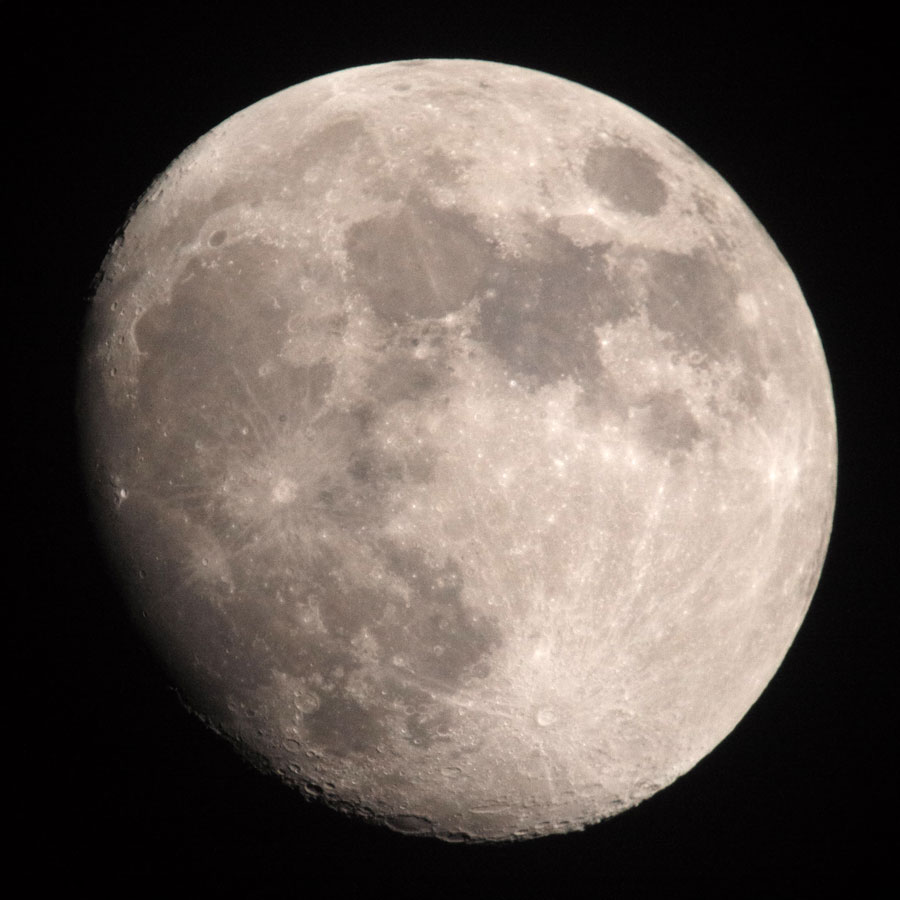 |
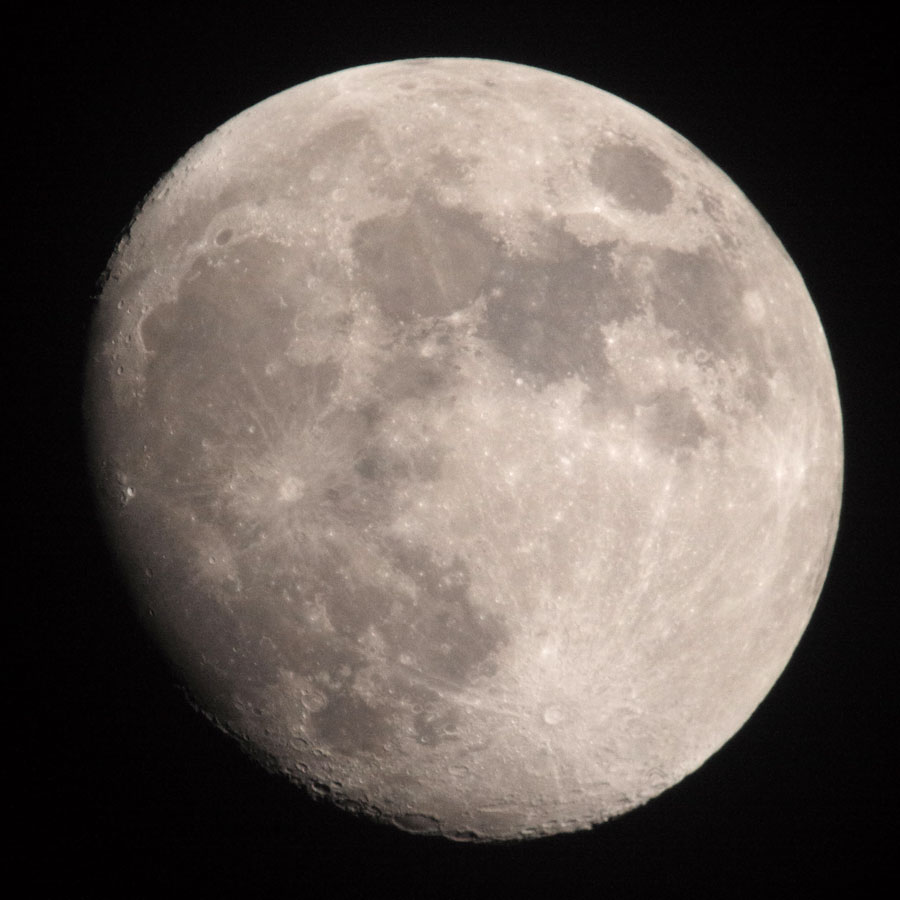 |
|
Post-processed, exposure time 1/750 sec - 2700 pixels |
Post-processed, exposure time 1/750 sec - 2700 pixels |
|
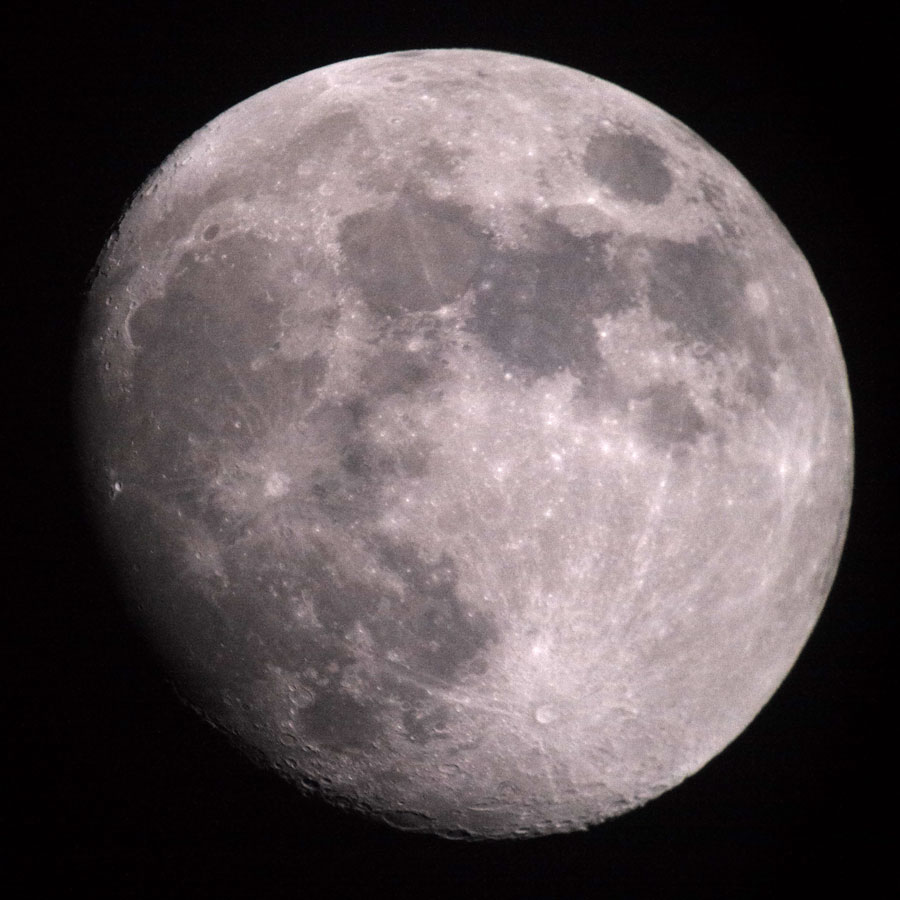 |
 |
|
Post-processed, exposure time 1/1500 sec, somewhat underexposed - 2700 pixels |
Post-processed, exposure time 1/1000 sec, nevertheless blurry - 2700 pixels |
|
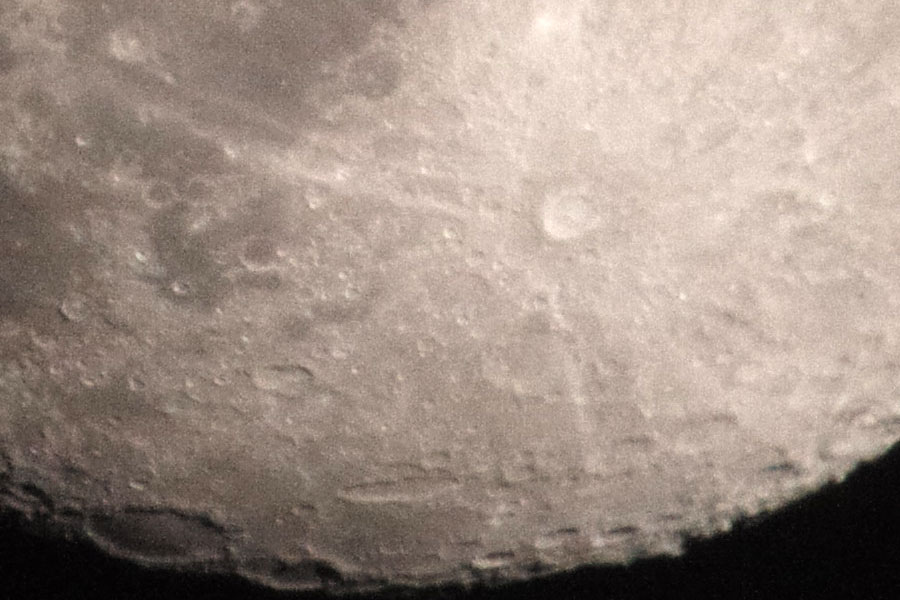 |
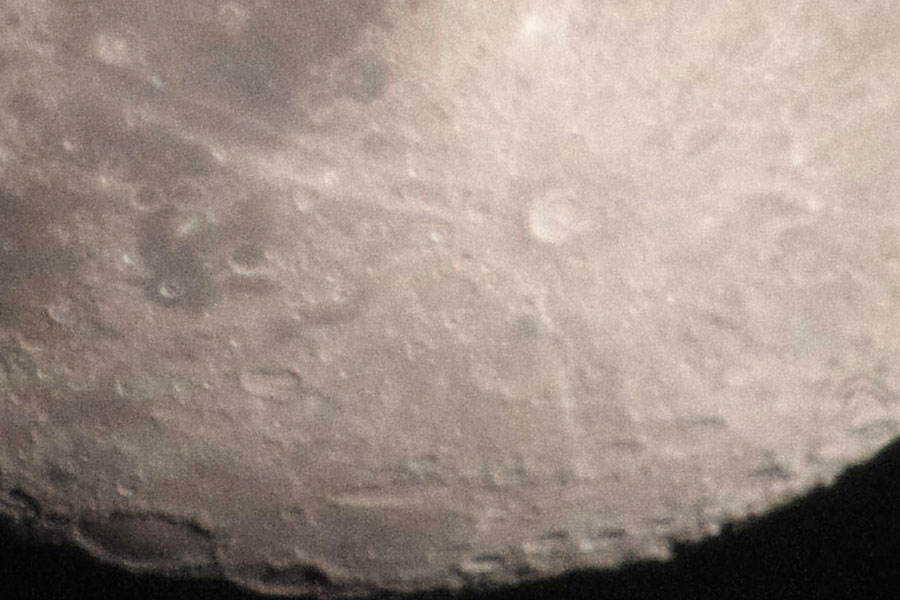 |
|
Section from the southern hemisphere, my sharpest sample |
Ditto; same exposure time, but less sharp |
|
 |
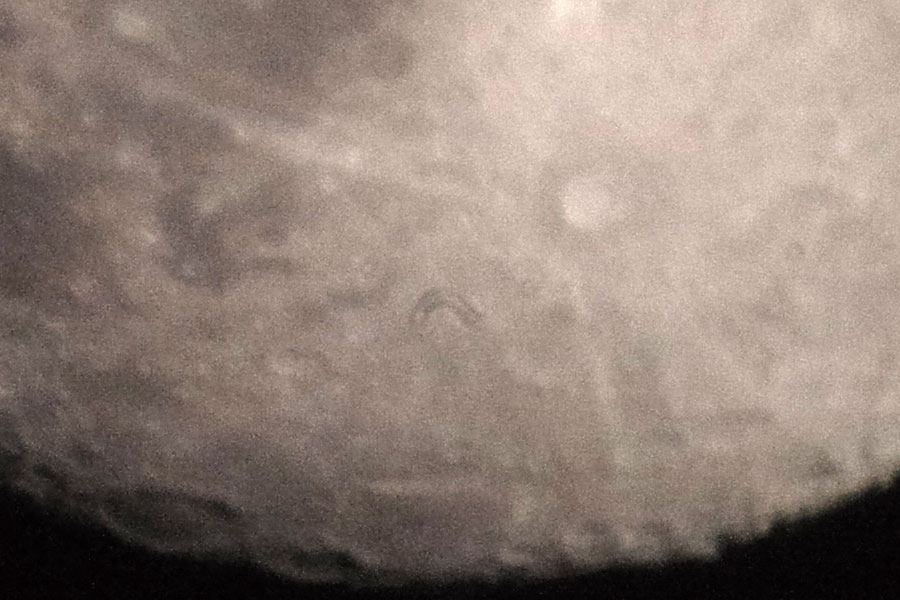 |
|
Ditto; more noise due to underexposure and less sharp than the photo above that has twice the exposure time... |
Ditto; despite of only 1/1000 sec exposure time blurred... |
| 17.11.2024 |
